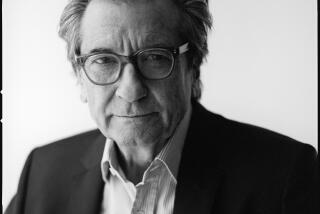The ‘80s teenage angst fest ‘The Breakfast Club’ gets a high-class video release
“The Breakfast Club” is an unorthodox choice for the highbrow cinema canon, but its release as a Criterion Collection Blu-ray this week shouldn’t come as a complete surprise. Putting aside questions of quality, is there any high school movie more seminal than John Hughes’ 1985 pop-culture phenomenon?
Elemental in its approach, with one primary location and very little action, the film strands five archetypal teenagers — played by Emilio Estevez, Anthony Michael Hall, Judd Nelson, Molly Ringwald and Ally Sheedy — in a high school library for an all-day detention session. Left to their own devices, the kids move beyond an initial hostility to work through their anxieties with frankness and mutual recognition.
“Clueless,” “Dazed and Confused,” “Election,” “Metropolitan” and “Rushmore” are all more aesthetically distinctive and sociologically precise teen movies, but “The Breakfast Club” comes by its iconic status honestly. It’s the most significant teen movie that feels like it was made by a teenager.
“The Breakfast Club” sidestepped all the clichés of the teensploitation movie — no homecoming dance, no keg party, no nudity, no football game. Sandwiched between Hughes’ equally beloved directorial efforts “Sixteen Candles” and “Ferris Bueller’s Day Off,” “The Breakfast Club” presented as something weightier: a sincere group-therapy drama, with delinquents turned into soul-searchers by virtue of their daylong confinement and a dearth of distractions.
Hughes’ screenplay presents a series of straw-man stereotypes (“the brain, the athlete, the basket case, the princess and the criminal”) then takes 90 minutes to easily dismantle them. The lessons seem clear: People are more complicated than you give them credit for, and deep down, everybody feels like an outsider.
In Hughes’ Shermer, Ill., the fictionalized northern suburb of Chicago that provided the setting for several of his films, the characters are always white and broadly middle-class. This Saturday detention is meant to resemble a prison; “The Breakfast Club” doesn’t acknowledge that it’s also a cocoon.
So if “The Breakfast Club” remains unusual for taking suburban teenage ennui seriously, you might also need to be a teenager to stay on its wavelength.
For those equal to the challenge, the film remains an enduringly popular generational touchstone. Jason Diamond, author of the memoir “Searching for John Hughes,” said in a recent interview that the film “does as good a job as one could do show[ing] the many conflicted sides of a teenager without getting too heavy for too long. When we talk about how John Hughes really understood and cared about his teen characters, we say that because of ‘The Breakfast Club.’”
In interviews over the years, the film’s actors made clear that they saw Hughes, then a married man in his mid-30s, as a compatriot. Off screen, the director — who died in 2009 — was a close friend to both Ringwald and Hall, and in the film’s climactic scene, when the characters share intimate revelations while sitting in a semi-circle, Hughes sat on the floor with them.
The characters never extend their vocabulary or frame of reference beyond that of a 16-year-old, and some of the screenplay’s coinages (“wastoid,” “brownie hound,” “hot beef injection”) wormed their way into high school slang.
Even when the emotional logic of “The Breakfast Club” seems juvenile, it’s possible to appreciate the film’s subtle craftsmanship. In David Kamp’s essay for the Criterion release, he notes that Hughes shot more than a million feet of film over the course of a 32-day shoot. The film was also shot in sequence to encourage an emotional bond among the performers.
Sheedy has many of the film’s unforgettable moments playing the unbalanced loner Allison. At one point Allison shakes her dandruff onto a notebook page to create snow for a drawing, and when she assembles her Cap’n Crunch and Pixy Stix sandwich, the sound design is impeccable.
Sheedy is a marvel, but she doesn’t speak for the film’s first half-hour, ceding the space to Nelson’s boisterous blowhard John. It’s an obnoxious performance that too often sucks all the air from the room.
John’s invasive taunting of Claire, the pampered, vulnerable popular girl played by Ringwald, borders on sexual assault, and her eventual embrace of her tormentor is hard to stomach. But the bullying lays bare the film’s complicated relationship with its own misogyny. In an essay, novelist Julianna Baggott wrote that “The history of ’80s virginity can be broken into two eras — pre-‘Breakfast Club’ and post-‘Breakfast Club.’ Because, that’s when the truth was first spoken — The Prude/Slut trap, the Double-Edged Sword of our Fragile Sexuality.”
Nobody would mistake Hughes for a progressive voice on gender politics. And though the film ends with a freeze-frame of Nelson’s defiant pumped fist, writer P.J. O’Rourke tried to use the movie as an indicator of his friend Hughes’ supposed conservatism. “There’s nothing revolutionary about ‘The Breakfast Club,’” O’Rourke wrote for the Daily Beast. “On purpose. The kids don’t try to abolish authority and institutions. They elude and modify them with wit.”
But they’re adolescents, and full of contradictions. In the New Yorker, critic Pauline Kael called the characters “a bunch of stereotypes who complain that other people see them as stereotypes.” A more generous reading might say “The Breakfast Club” is about the way teenagers use and inhabit stereotypes to mask their emotional need.
The film’s oft-quoted line “When you grow up, your heart dies,” is, in context, hardly presented as a mantra. But “The Breakfast Club’s” appeal to its target audience is obvious: it flatters and sanctifies adolescence as a time of wisdom and emotional clarity, a small window of time in which one’s individuality is there for the taking.
More to Read
Only good movies
Get the Indie Focus newsletter, Mark Olsen's weekly guide to the world of cinema.
You may occasionally receive promotional content from the Los Angeles Times.










